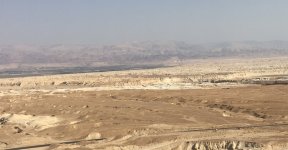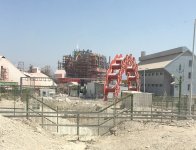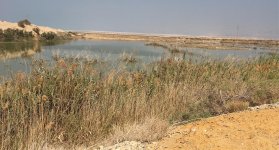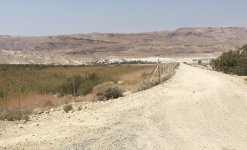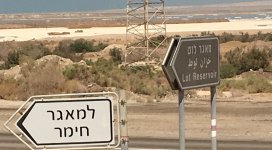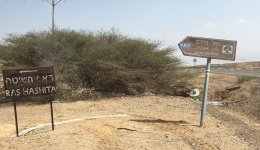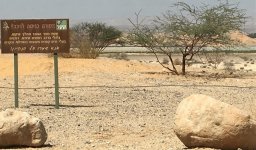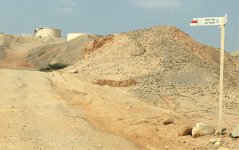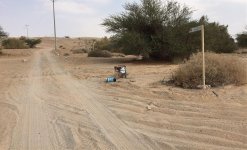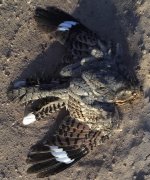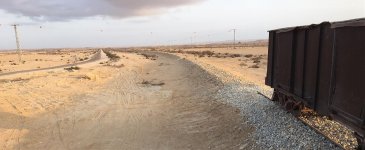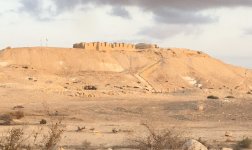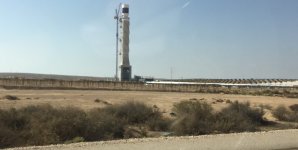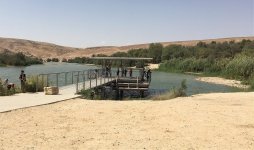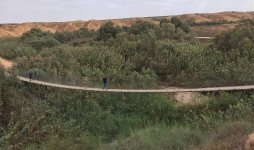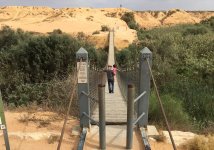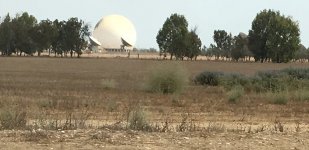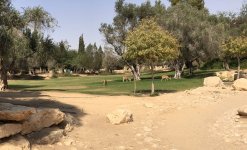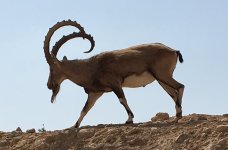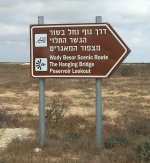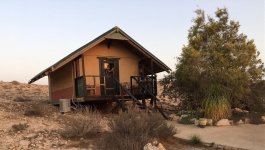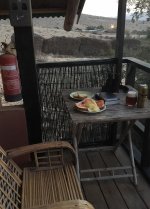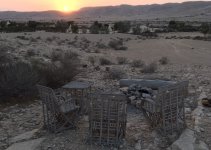wolfbirder
Well-known member
Logistics
This trip was specifically planned for this usually unpopular time of year to bird in Israel, as I hoped to see 3 fairly difficult Western Palearctic raptors - Sooty Falcon, Lanner Falcon, and Levant Sparrowhawk, that I badly wanted to see, and then there was always other lifers I saw the potential to catch up with such as MacQueen's Bustard, Smyrna Kingfisher, Arabian Warbler, Nubian Nightjar, and various species of Sandgrouse.
Some of these are much easier in March/April however, though my equally-short Israel trip two years ago to Eilat had not produced these species. I did not even get up early enough that time, to go to Nizzana. Sadly, I drew a blank in relation to seeing the owls of the region on both dates. Visits to see Desert Tawny Owl are now strictly restricted and controlled.
Flights with EasyJet from Stansted to Tel Aviv cost a little over £250, car hire with Hertz (again I wanted to use a company which had its own desk in the airport) cost around £200 including CDW and a full petrol tank, and accommodation at the wonderful Sde Boker Vineyards cost around £450 for 4 nights. Israel is not cheap!
Most people visiting at this time of year go to the Hula Valley in the north of the Country, it can be intensely hot in the Negev until mid-October, and indeed in the afternoons the temperature reached over 30C, too hot for birds and too hot for me! So most birding was done in the mornings, and late afternoon. I was lucky as it had been as hot as 35-40C in recent weeks, but my visit fortuitously coincided with a slightly cooler period. Also, I knew that 90% of birding could be done from my air-conditioned car, a critical consideration for me.
Sde Boker was purposely chosen as a base, it was only around 100 miles from Tel Aviv Airport, and it was the area where I was likely to see my 'wanted' raptors. The Dead Sea and Hazeva were just an hour away, and other locations like Nizzana, Ashalim, Revivim, Ha-Besor NR, Yerochum less than half an hour away, with Urim just a bit more. I've yet to see anyone use Sde Boker as a base in Israel other than for a night, or see birders base their stay entirely on the Negev region. Perhaps the lure of Eilat in March / April, or the Hula Valley up in the north in Autumn, is just too great. Unless you had identical target species as me, then choosing those areas primarily, is understandable. Those areas are undeniably where Spring and Autumn migration can best be witnessed. But I was not going to Israel this time for sheer quantity or for a wide variety of species anyway, this was very much a 'specialist species' trip, if I might call it that.
I was better prepared to understand the car hire system and road system this time. I photographed the mandatary car code that has to be punched in every time to restart the engine, and I knew the routes I wanted to take. Petrol stations are few and far between, so make sure you have enough petrol to get to your destination, and if possible pay by cash as using your credit card is a relatively complicated affair where you will probably have to ask for the help of the petrol station attendant, who sometimes speak little or no English. The pin number of your credit card is not used in Israel bizarrely. You may wish to stock up on snacks and water at petrol stations as well, as they seem to be more or less the only place to get food, unless you drive into the centre of towns. Not that they usually stack a great variety of food!
Off main roads, take care in standard hire cars, beware deep ruts, and of course study the state of sand-tracks at all times. Some of my photographs at the end, show the sort of sand you should keep out of. It is just common sense.
However, I was not prepared for my car to set off mini-alarm sounds each time I broke the speed limit, or approached a curb, or got too close to another car, or approached a bend, or crossed the central dash-lines. Bloody annoying I must admit, but I eventually just ignored these safety device features.
You also have to get used to Israeli drivers, they do get right up your arse, so much so that at one point I could see the male driver and his attractive girlfriend in my rear view mirror in intricate detail. She had a low-cut top on and arms rested upon her head, and it didn't take long for my sordid little mind to feel that I was watching an in-car porn video!
At junctions, there is absolutely no anticipation, everyone stops and waits at least 2-3 seconds before turning even when you can see hundreds of metres along the road before you get to the junction. I swear all Israeli drivers are taught by female driving instructors (yes I know I'll get flamed for that, and rightly so - ). To be fair, its probably an offence not to do this in Israel, but it contrasts wildly with the impatience of drivers overtaking you.
- ). To be fair, its probably an offence not to do this in Israel, but it contrasts wildly with the impatience of drivers overtaking you.
But, its all part of the experience, and for long spells in the morning, I had excellent main roads all to my self. Most desert tracks can be taken with care, but always assess the track ahead, and if in doubt, stop and go back. Getting stuck in sand is a real possibility in some stretches of some tracks.
Day to day itinery
22nd September 2017
Having arrived at Tel Aviv Ben Gurion Airport mid-afternoon, I was prepared for the scrutinisation at passport control. The young man I was beckoned towards knew he had the power, and as soon as I told him that I was birdwatching he gave me that "sad English tosser" look that I am actually quite familiar with. He asked me a few more questions, though I could barely hear what he said behind the glass, and I tried to squeeze my bald head at an angle through the narrow gap at the bottom so I could hear him, and enhance his impression of me still further!
Sad English tosser I maybe, but also a harmless one, I knew it, and he knew it too -.
-.
So on I went.
Instead of heading the 100 miles straight to Sde Boker, I headed eastward towards the Dead Sea area, noting camels high on the hills by Arad, which I thought seemed a strange location for them, but there must have been a Bedouin farm nearby. Views of the Dead Sea, with its weaving wadi's and square saltpans, with the towering Jordanian mountains behind, shimmering in the afternoon heat, provided a truly spectacular sight. The reason I was visiting the Dead Sea region was to visit Lot Reservoir, which is signposted just after joining Route 90. I spent at least an hour here, driving the raised track that looks down on the extensive reed-bed on one side, and a small reservoir on the other. I walked through the gates (don't drive in as it is private property, and someone warned me that the track is deadly for cars), briefly seeing 3 Little Green Bee-eaters, male Palestine Sunbird, and Lesser Whitethroat. 2 Little Egrets flew in late afternoon and a Red Fox trotted by, but there was absolutely no sign of any Clamorous Reed Warblers unfortunately. That would have been a nice life-bird for me. I was hoping to see Sooty Falcons that come down from the mountains at dusk to hunt bats, but I only found Kestrel, until I was about to leave as darkness fell at 7pm. Then, yes!! a superb adult Sooty falcon came into view for around 30 seconds, hunting over the reed-bed, providing quite reasonable close views. I could see the dark upper primaries that are characteristic.
Thrilled with this sighting, I then drove to Sde Boker, arriving at my desert lodge at Sde Boker Vineyards just after 8pm. This was booked via Booking.com. No wide-screen TV here, just a veranda and table and chairs to sit at, with a comfy bed and fantastic air conditioning, small kitchen and bathroom. Perfectly adequate. There was an information folder in my room and leaflets in reception, telling you that there was a cashpoint, petrol station, small mini-market, and even a pub in the centre of Midreshet Ben Gurion, just two miles away. Ideal. There was also a communal hot tub, but I didn't want to spend the 4 days being chased endlessly by beautiful young Israeli women, so no one got to see any bare parts of my torso - Ok, then I woke up!
- Ok, then I woke up!
Each morning I would eat my breakfast (I took cereal with me and bought local bread) on the veranda, and each evening I would eat cheese and tomato on local bread, with crisps, and some cake to finish with. Well, beer to finish with of course. It was wonderfully atmospheric watching the stars on a clear desert night, with nothing but the sound of crickets. Bird-wise, Chukars and House Sparrows were always present, and I also had Hoopoe, Bee-eaters, a family of 5 Arabian Babblers, and up to 20 Tristram's Starlings and a Mourning Wheatear by the entrance some mornings.
Oh, and Crested Larks, which are everywhere in the Negev. In stark contrast to the Norfolk Pallas's Grip-offer Warbler I managed to glimpse a week or two ago, these birds jump out of any cover into the path of your car, and issue their piercing three-note call that eventually begins to sound like "Look at me!" After four days though, it began to sound like "Just **** off".
Collared Doves, and to a lesser extent Laughing Doves, are also omni-present wherever you go, along with Feral Pigeons.
23 September 2017
After about 4 hours sleep (I always struggle away from my own bed), I was up eating my breakfast on the veranda at 6am, and quickly out to do some birding. I headed the short distance to Nizzana on Route 211, just a half-hour drive away. En route, I stopped near Ashalim, where there is an imposing 250m-tall Solar Power tower under construction. Near here, I stopped to watch 3 Hobby's flying between trees by the road side, and then I saw a much larger falcon away to my left. I couldn't see much colouration, but the jizz, profile and size led me to conclude that this was very likely an adult female Lanner falcon. Anyway, onward I went, aware that I had to get to Nizzana by about 7am. I failed to get here from Eilat two years ago, so knew this was my big chance to find MacQueen's Bustard, though at this time of year they are extremely secretive. At Nizzana, I took the road to Ezuz as signposted, passing the 'giant-sand-castle-like' Nizzana Fortress to the left, and drove 7-8kms out to the railway carriage hide that is extremely straightforward and easy to see and find. Chukars and a pair of Sand Partridges were seen along the 7km stretch, as well as a few posturing Brown-Necked Ravens, Mourning Wheatears and Southern Grey Shrikes. And of course - Crested Larks. I also managed to find 4 Dorca's Gazelle's that were typically skittish. I was just about to give up my thorough scrutinisation of the terrain on all sides of the train-hide, when far away to the left I suddenly noticed a MacQueen's Bustard walking slowly through a bunch of bushes. Views for twenty seconds were poor, but I knew exactly what it was, before it disappeared from view. I tried to drive back to a spot along the track that would bring me closer to the bird, but I failed to relocate it, only managing to flush a party of 7-8 Arabian Babblers.
Nevertheless, pleased that I had at least connected, I drove back to Nizzana and followed instructions to find a series of pools by the prison, but failed miserably over half an hour. I suspect these particular ponds might now be overgrown, and all I could find in ploughed fields being watered were 3 Tawny Pipits, 5 Eastern Yellow Wagtails, and a White Wagtail. An obvious reservoir at Nizzana on the opposite side of Road 211 did produce a few waders as well as 3 Squacco Herons and a Long-Legged Buzzard. But it was disappointing not to have been able to find the pools where Sandgrouse come to drink. I'd researched this carefully, but as usual, I seem to feck up somehow at the last moment.
I progressed northward to the Upper Negev area, and as I turned on to Route 222, I noted 3 Rollers on roadside wires, always cracking birds to see. I was heading to the raptor-heaven of Urim (well, it will be in November and December), but first of all I noticed on my map a rough but driveable 10km-long track that took me near to Urim, along what was called the Ha-Besor Reserve (sometimes called Ha-Bsor). This was clearly signposted, and as soon as I turned onto the solid gravel track I noticed Black Kite and Lesser Kestrel in flight, and a Collared Pratincole that shot past. Shortly afterwards, I parked up by a wonderful 'rope-bridge' that led over a reed-bed. This was a great and opportunistic stop, providing half an hours good birding. 2 Little Bitterns, juvenile Bluethroat, and up to 10 Palestine Sunbirds showed extremely well. One male of the latter species posed in the late morning light just ten metres away, revealing its exquisite, iridescent green and purple plumage. As I moved along this track, the terrain changed somewhat, and some great birds were seen. Around 70 Bee-eaters at three different spots were showy, as were a few Masked, Red-Backed, and Southern Grey Shrikes. Hoopoe, Swallows, Isabelline Wheatear, 3 Northern Wheatears, several Yellow-Vented Bulbuls, Chukars, Hooded Crows, Kestrel, and up to 40 Black Kites were also seen, but the best birds along this track were a lovely juvenile Montagu's Harrier, and a close Smyrna Kingfisher (also known as White-Throated Kingfisher). The bird flashed across the track, and flew down to the reed-bed one hundred metres away. Shame I couldn't relocate it, but it was a very welcome lifer for me.
I rejoined Route 234, and headed to the famous fields of Urim, with its famous landmark radar dome. In several weeks time, the fields and telegraph poles will be crammed with eagles, harriers and falcons, but today I had to be content with around 70 Black Kites, 2 Kestrels, and a wonderful adult Black-Winged Kite that showed very well for me. What a lovely bird.
On the way back to Sde Boker, I visited Yerochum Lake, but being a weekend this was extremely popular with locals. Again, it was possible to drive most of the way around its perimeter without leaving the air-conditioned car, and in half an hour I saw 15 Night Herons, a dozen Grey Herons, several Spur-Winged Plovers, Spotted Flycatcher, Marsh Harrier, Palestine Sunbird, juvenile Whiskered Tern, Mediterranean Gull, 30 Mallards, and a dozen Coot.
Before returning to my lodge, I accessed Sde Boker Kibbutz, slowly driving around the tracks noting 15 Laughing Doves, Hoopoe, Black-eared Wheatear, Spotted Flycatcher, Syrian Woodpecker, 5 Eastern Yellow Wagtails, 2 Sand Partridges, 2 Yellow-vented Bulbuls, several Spur-winged Plovers, 3 Arabian Babblers, Masked Shrike, and an Isabelline Wheatear - quite a good haul to be fair. Several Common Myna's were present nearby, these birds seem to have established themselves in this area as well as at Tel Aviv Airport.
I also checked out the viewpoint at the Midreshet Ben Gurion, which overlooks Ein Avdat and the Zin Valley cliffs. Various eagles and falcons nest on these cliffs, but at this time of year they were elsewhere. You can pay to go on a jeep tour down into the valley, but these tours are very expensive and not tailored to birdwatchers. In March and April, nest locations are known, so it is possible to see the Lanners at or near their nest, from the viewpoint.
After a rest at my lodge, I came back out at 5pm, and it was fairly breezy, which was pleasant. I drove the short distance to Sde Boker Kibbutz again, as migrating Levant Sparrowhawks have been known to roost here at this time of year, and indeed my luck was in. 6 male Levant Sparrowhawks were circling low over the trees of the Kibbutz, offering quite excellent flight views. I was really happy with this sighting, another lifer under the belt, one I was not really too confident of connecting with. A group of Bee-eaters flew past distantly, looking very much like Blue-Cheeked Bee-eaters to me. Another great species to see, but I was not too concerned about the poor views, as I had seen them fantastically well in Turkey previously.
I retired to my accommodation, having enjoyed a fantastic first full day in Israel. I was really pleased to have connected with the Macqueen's Bustard, and especially the Levant Sparrowhawks, plus the putative Lanner. Great views of shrikes, Palestine Sunbirds, and the Black-winged Kite really rounded off a fantastic day.
24 September 2017
I enjoyed a leisurely veranda breakfast today, as I had arranged to meet Negev expert-guide Meided Goren by the gates of my accommodation at 8.30am. Costing an approximate £180, I paid this as I wanted to see Sooty Falcons closer at hand, and there was no better person to show me them, as Meided was a leading Sooty Falcon co-ordinator who had searched for nests as part of the project to estimate how many there were in the Country - I think he said around 70 pairs.
First of all, we birded around Sde Boker fields, off Route 40, which are adjacent to a reservoir pool of water clearly visible from the main road. Take care pulling off though, as traffic is fast. 70 Shovelers, as well as Little Grebes, Teal, and Mallards were present, with the usual Spur-Winged Plovers on the banks. We noted 20 Levant Sparrowhawks leaving the nearby Kibbutz roost, so more than the 6 I had seen the previous evening, had roosted. An adult Egyptian Vulture was seen distantly, and in the orchard adjacent to the reservoir, we found eastern-race female Redstart, Red-rumped Swallow, 2 Willow Warblers, Hoopoe, and 2 Red-backed Shrikes, but no hoped-for Desert Finches, a bogey-bird of mine! We then drove around the tracks of the fields, noting 20 Black-bellied Sandgrouse that offered fine views, 15 Short-Toed Larks, 3 Turtle Doves, and the usual Crested Larks. Lanner has often been seen here by Meidad, often at this time of morning, or between 6-7pm, often in the field itself, or on roadside telegraph poles, but I never connected here unfortunately.
After an hours birding here, Meidad said "Lets go and see the Sooties!" This involved an hours drive back to the Dead Sea area, and Long-legged Buzzard, Mourning Wheatear, Isabelline wheatear, and several Brown-necked Ravens were roadside birds en-route.
Meided pulled unexpectedly into a sort of roadside lay-by as we descended towards the Dead Sea, and said "we are here". No sooner had I got out of the car, into a wall of heat, than an adult Sooty Falcon flew in front of us, and then directly above us, offering splendid views for around a minute. I could see the orange legs that identified it as the adult male, as it was circling just above us. We crossed the road, and set up scopes, looking at the cliff-face nest-hole, where 3 young chicks could be seen. Within five minutes the adult female, with distinctly yellow legs, returned with prey - a Crag Martin according to Meidad - which she proceeded to pluck, tear apart, and feed mainly to the smallest chick of the three, with unobscured views of this action filling the scope. Simply fantastic, and worth every penny for me. I told Meidad that I had to retreat to the car after about ten minutes, as it felt like standing in a micro-wave to this pathetically pale Englishman. He laughed, but fully understood. Twenty minutes is all I had enjoyed, but super views were soaked in, and I was thrilled to be honest. As we left, both adults were spiralling high into the sky. Beautiful falcons, surprisingly powerful, and I felt privileged to have seen them so bloody well!
As we drove back, we had a good chat about birding, including Meidad's passion for Albatrosses, his bogey bird (Lammergeier), and like me being a late Dad. Indeed, we had earlier bumped into his lovely wife and bouncing young boy as we drove around Sde Boker. A smashing bloke and great guide. At my request I asked to finish early, so he dropped me off back at Sde Boker petrol station where I transferred back to my hire car. I had a major meltdown here, temporarily losing my hire car keys. Meidad stayed with me, tried to stop me flapping, and even rang Hertz twice, firstly to explain that I had lost my car keys, and then ten minutes later to say I had now found them and hence to cancel the pick up truck and replacement car that were on stand-by! Thanks a million Meidad, and my sincere apologies. Nevertheless, we laughed about it, and he shared his story of having got lost on a first night-out in London, having lost his mobile phone and not even knowing the address / area of the relative he was staying with. It's just that temporary feeling of helplessness, that is actually quite alarming, at the time.
Meanwhile, 'back at the ranch', I had an hours lie-down to get over the shock and embarrassment of my car key episode, and to reflect on the great views of the Sooty Falcons. At 2pm, in the worst heat of the day, I decided to go back out to Sde Boker fields, where I enjoyed stunning views of 34 Black-bellied Sandgrouse, 25 Spur-winged Plovers by the reservoir, 2 Red-backed Shrikes, and a Common Raven. But best of all, for me, a Golden Jackal walked nonchalantly through the orchards I had earlier birded. It glanced at me in my hire car, before trotting off into the dense undergrowth.
At 3pm, I set off for the Dead Sea again, and then onto Hazeva, for I had arranged to meet my second guide of the day at Hazeva Field School, which is signposted, and easily found just a hundred or so metres off Route 40 around km155 post. The young girl named Inbar met me at 4.30pm at the entrance gates, and from there we continued along the road where the Field School is situated, and after less than a mile, turned left where Wadi Gidron and Ras Hashita is signposted. The obvious track leads between huge green-houses, bends behind them, but then you must turn right where only 'Ras Hashita' is next signposted. Continue along the track for a few hundred metres through shaded trees, and then at the end of the trees, where you emerge out into the open, take an S-shape turn, doubling back on your self, turning right first of all, then left. This immediate area is said to be good for Namaqua Doves but none were found unfortunately. You can then progress along the track a mile or two out into the desert and areas of Acacia trees, but despite tape-luring we could not find any Arabian Warblers at favoured spots.
The feeling of 'deja-vu' was setting in a bit, but we rejoined the road off Route 40 where the Field School is situated, and drove further along it, eastward towards the Jordanian border, until a sign for Shezaf Nature Reserve takes you to this famous location, where Arabian Warbler is reasonably reliable. Many people, or reports, talk about 'accessing' Shezaf at km152 off Route 40, but cars can get stuck in the sand along that access track I am informed. This 'signposted' route is much easier, and there is little chance of getting bogged down in sandy tracks, and it is the one Israeli birders use, so no wonder Meidad and Inbar were perplexed when I asked them about the km152 access point reported by so many UK birders. The signposted route we went on winded its way past greenhouses, a rubbish-dump, and mini-power sub-stations, and after a few miles, and just before two obvious hillside water tanks (referred to as 'Shezaf Look-out'), turn left onto the track where a sign-post says En Yahav. Then continue on for a mile or so, go over the brow of a hill, and the best cluster of acacias lies ahead. A sandy crossroads and an old metal oil drum mark Shezaf NR. Park with care here, where the tracks are not too sandy. Inbar works closely with the Arabian Babblers here as part of her research, and they immediately came towards her, but of course we were after Arabian Warbler. She again played its call, but we had no response. 2 Palestine Sunbirds, a couple of Red-backed and Southern Grey Shrikes, Hoopoe, and a Desert Lark showed well, and then I noted a small warbler flitting around the largest acacia tree right by the car. I walked around the blind side so the sun angle was perfect, and enjoyed fantastic views of a singing Arabian Warbler, with its blackish eyes, crown and bobbing black tail. I could not believe how confiding it was, bearing in mind how elusive they can be even after locating them.
We continued to look for Namaqua Doves as we drove back the same way to Hazeva, but could not connect at several favoured spots. It was now 6pm, and time to drive 20 miles northward to Ne'ot Hakkikar by the Dead Sea, where we searched for Nubian Nightjars at a number of spots for an hour. I was sceptical as none had been located the previous night, and it is just not a good time of year to see them. They simply don't respond to tape-luring, and despite spot-lighting every furrow in every field, we lucked out! Not through lack of effort though. However, we did sadly come across a fresh Nubian Nightjar corpse on the road. It was fully intact, and ironically, I was able to examine it at extremely close quarters. This was the only Nubian Nightjar I had ever seen, dead and untickable of course, but I had still at least seen one in the wild, albeit in sad circumstances. Not much else was seen, just a few bats and a gerbil. Feeling a bit queezy due to the humidity and lack of air here, below sea level, I asked Inbar to return me to my hire car slightly prematurely. But she had more or less finished anyway. I thought I was going to faint or throw-up, maybe both. Back at my hire car, I blasted up the cold air-conditioning, and soon came round again.
I drove back to Sde Boker, arriving at 9pm. Another good day had been enjoyed, with supreme views of Sooty Falcon and Arabian Warbler, and an interesting perspective of Nubian Nightjar.
25 September 2017
Today I was back birding on my own, but made the most of tips given to me by Meidad.
First port of call was Revivim Pools twenty miles away, and between 8-9am I was to enjoy quite superb birding here. The village of Revivim is signposted, and then you take the first right-turn to the pool. I drove around the small fenced-in pool, noting much bird activity, including 3 Graceful Warblers, Eastern Bonelli's Warbler, Eastern Olivaceous Warbler, several Yellow-vented Bulbuls, and 2 juvenile Red-backed Shrikes. Collared Doves were all around and Swallows fed over the water. When I accessed the opposite raised side in my car, the light angle and viewing position was far better, and I could see that there were several waders present including 6 Spur-winged Plovers, 2 Black-winged Stilts, 2 Ruff, 2 Common Sandpipers, and a flock of Feral Pigeons on the banks. 5 Little Grebes were on the water. After half an hour, a number of Black-bellied Sandgrouses came in and landed in the adjacent field. Eventually these totalled 120 birds, with some coming to the bank of the small reservoir to drink. At the same time, raptor activity increased. A flock of 102 Levant Sparrowhawks circled and passed through, away to the left, and another 30 soon followed in dribs and drabs. An adult male Honey Buzzard circled, and briefly landed in a small tree, followed by an all-dark-brown bird of the same species. They soon moved off again without taking a drink, and then I noticed a falcon approaching from the left. I got straight onto it, as it flew across the pool at eye level. Head-on initially, I knew instantly that this was a splendid Lanner Falcon, due to its head pattern. White forehead, and solid rufous crown extending to the nape were obvious features, and face and underparts were whitish, with indistinct malar stripe. Upperparts were bluish-grey. There may have been a thin line of black on the crown separating the white forehead from the rufous crown. The view was superb but brief, as it raked across the pool. In contrast to Peregrine, Barbary, Saker, or Gyr, it was not so bulky or broad-chested, but still an impressive-looking raptor, and its presence put up around 300 Collared Doves and Feral Pigeons. Lanners are endangered and reducing in number, and this was probably a male due to its smaller proportions, of the middle-eastern race 'tanypterus'.
The quality birding here was not finished. Around 15 Spotted Sandgrouse arrived in small groups of 4-5 birds, and briefly touched down to drink. They offered excellent views. Another lifer.
At 9am I moved on, checking the periphery of Ramat HaNegev Agricultural Centre, which was nearby and amusingly signposted as Ramat HaNegev Agro Centre. But I could not find any Desert Finches here either, though Turtle Dove, Syrian Woodpecker, 5 Greenfinches, Southern Grey Shrike, and Red-backed Shrike were seen. Birding was becoming too hot by 11am, so after briefly checking out Yerochum Lake again, and then Sde Boker fields, I returned to the ranch to rest.
I received a message early afternoon from Meidad (still trying to help me!) that 2 Namaqua Doves had been seen that morning in the housing estate at Midreshet Ben Gurion. So in the afternoon heat, with my broad-rimmed hat on, I trudged around trying to peer over walls and fences into various gardens. An adult Masked Shrike, 2 juvenile Red-backed Shrikes, 4 Bee-eaters, Black-eared Wheatear, 6 Common Mynas, and Laughing Doves were seen, but eventually I gave up on the Namaqua Doves. At nearby Sde Boker Kibbutz a Wryneck, Northern Wheatear, and a Blackbird were seen.
I went to the viewpoint at Midreshet Ben Gurion for the last time to look at the spectacular Ein Advat and Zin Cliffs, scanning for any raptors in the distance, a futile operation bearing in the mind the distance and scale of things.
So I finished the day eating and drinking on the veranda at my lodge, again reflecting on the birding, especially the superb hour I had enjoyed in the morning at Revivim where I saw Spotted Sandgrouse, Black-bellied Sangrouse, Honey Buzzards, Levant Sparrowhawks, and that superb Lanner Falcon.
26 September 2017
After my last night, I checked out, having really enjoyed my stay at this desert oasis. I still had a full day of birding ahead, with my flight from Tel Aviv leaving at 8.30pm.
I decided to revisit the Hazeva area on the Dead Sea coast, but instead of going via Dimona, at Yerochum I took a mountainous route eastward on Road 225. This road is very quiet but occasional quarry-lorries can come rumbling along. I stopped a few times at the highest point, noting Desert Lark, female Blue Rock Thrush, distant migrating Montagu's Harrier, and a family of House Sparrows miles away from human habitation interestingly. At a picnic site called ' Colored Sands' a pair of handsome Blackstarts, Desert Lark, and Willow Warbler were found, and several Rock Martins (Pale Crag Martins) were seen by a viaduct, and at the end of 225 where it re-joined the main road, I enjoyed great looks at a Mourning Wheatear, and an adult and juvenile White-Crowned Black Wheatear. A Long-legged Buzzard also showed well on a telegraph pole along the main road I thereafter joined, but little did I realise that this was a really sensitive area where a nuclear-power station is situated. So I was perhaps lucky not to be swooped on by Israeli security staff, who do a hell of a lot of swooping according to Meidad, as we had actually witnessed the previous day, where an unfortunate driver had broken down on the main road going past this place.
Primed with knowledge of where to access the areas at Hazeva, I again checked-out Shezaf NR, but could not find the Arabian Warbler this time. 3 Blackstarts, 2 Southern Grey Shrikes, 2 Palestine Sunbirds, and 6 Dorca's Gazelle's were seen.
I again accessed Wadi Gidron where signposted, near the Hazeva Field School, and as I made my way out towards the areas of acacia, I suddenly saw several, small, long-tailed doves in flight. Instantly I knew what these were - Namaqua Doves! At last I had managed to find some. Over the next twenty minutes I watched them from my car. A male in fading plumage was sat in one small tree, and 4 others split between two adjacent trees. Eventually they flew down to feed on the floor underneath a small tree, in the shade. A total of 6 birds were seen, though I suspect most were juveniles as none had a black breast.
I also enjoyed crippling views of a Little Green Bee-eater in a tree, panting heavily in the burning heat of the day, and a Cape Hare scuttled into the undergrowth. A possible Desert Finch flew over, but it was moving away before I managed to get onto it. So no tick there!
It was time to move northward, so I drove back to Route 6 via the Dead Sea, where I enjoyed my last views of the eye-catching wadi's that hold those secretive Desert Tawny Owls. Back on Route 6, I saw a number of large raptors overhead, mainly Black Kites, but they may have included larger eagles, which were being reported north of Tel Aviv in considerable number. These were not my target species thankfully.
Last port of call was just off Route 6, at Timorim Pools, which judging by the condition of the vegetation around the access gates, had not been closed for some time. A driveable track around each of the large reservoir pools allowed good viewing of all the birds present. The main feature was the presence of several hundred Glossy Ibises, but on the water 200 Mallards were accompanied by 50 Shovelers, 20 Little Grebes, and pleasingly around 10 Marbled Ducks. A number of waders were present, including 200 Spur-winged Plovers, 50 Ruff, 2 Common Sandpipers, and single examples of Ringed Plover, Greenshank, Snipe, and Black-tailed Godwit. 3 Rollers offered superb views, either on fence-posts or just in front of the car on the track. A Southern Grey Shrike and Kestrel were hunting, as well as a Marsh Harrier that was almost all-black except a tiny white nape-patch. In fact I have never previously seen a Marsh Harrier like this individual. Perhaps best bird here however, was a superb juvenile Montagu's Harrier that showed wonderfully, hunting the banks of the reservoir or perched on the ground.
It was time to move on sadly, so I packed my optics away, and drove the short distance towards Tel Aviv, where I got lost on the motorway system, before relocating and finding the airport in time to check-in. Eurasian Sparrowhawk, 2 Ringed-necked Parakeets, and several Common Mynas were seen near the airport, and that ended the birding.
Check-in was less painful than expected, though an over-packed EasyJet plane meant some bags had to be taken off, and hence we missed our take-off slot, arriving home at 1am. I arrived back home just after 3am.
Overall, this had been a superb short trip, exceeding my expectations. I enjoyed fantastic views of my main targets - Sooty Falcon, Lanner Falcon, and Levant Sparrowhawk. Additionally, I had connected with MacQueen's Bustard, Spotted Sandgrouse, Namaqua Dove, and Arabian Warbler. 7 new bird species, or lifers.
Add to that, great views of Palestine Sunbirds, Black-winged Kite, shrikes, wheatears, babblers, and bee-eaters.
A truly enjoyable trip.
Bird list
Little Bittern - 2 at HaBesor NR
Night Heron - Around 15 at Yerochum Reservoir
Squacco Heron - 3 juveniles at Nizzana Pools
Little Egret - around 5 birds seen
Grey Heron - at least 10 at Yerochum Reservoir, and 5 at Sde Boker fields
Glossy Ibis - at least 300 at Timorim Pools
Egyptian Goose - a pair of adults at Timorim Pools
Teal - at least 10 at Sde Boker pool
Mallard - 200 at Timorim Pool, 50 at Yerochum Lake
Shoveler - 70 at Sde Boker pool
Marbled Duck - around 10 at Timorim Pools
Honey Buzzard - 2 birds at Revivim Pool
Black-winged Kite - adult at Urim
Black Kite - over 100 birds at various locations
Egyptian Vulture - at least 1 adult at Sde Boker fields
Marsh Harrier - 4-5 birds at different locations
Montagu's Harrier - 3 juveniles at HaBesor NR, Yerochum, and Timorim Pool
Sparrowhawk - single bird at Tel Aviv
Levant Sparrowhawk - 20-plus birds at Sde Boker Kibbutz roost, and 130 passing Revivim Pool
Long-Legged Buzzard - 1 at Nizzana, 1 by Sde Boker, and 1 east of Yerochum
Lesser Kestrel - an adult male at HaBesor NR
Kestrel - up to 10 birds seen
Hobby - 3 birds seen along Route 211 by Ashalim
Sooty Falcon - 1 adult at Lot Reservoir, 2 adults at Dead Sea nest-site along with 3 youngsters
Lanner - putative adult female at Ashalim, adult male at Revivim Pool
Chukar - at least 200 seen
Sand Partridge - pairs seen at Nizzana and Sde Boker
Coot - 15 birds at Yerochum Lake
MacQueen's Bustard - single adult very distantly at Nizzana
Black-winged Stilt - several birds seen at various water pools
Collared Pratincole - single bird in flight at HaBesor NR
Ringed Plover - single bird at Timorim Pool
Spur-winged Plover - a few hundred seen at various locations
Little Stint - at least 5 seen
Ruff - at least 60 seen
Common Snipe - single bird at Timorim Pool
Black-tailed Godwit - single bird at Timorim Pool
Redshank - several seen such as at Nizzana Reservoir
Greenshank - single bird at Timorim Pool
Common Sandpiper - several birds seen
Mediterranean Gull - juvenile at Yerochum Lake
Whiskered Tern - juvenile at Yerochum Lake
Rock Dove/Feral Pigeon - a few hundred seen
Collared Dove - up to 1000 seen
Turtle Dove - 3 birds seen
Laughing Dove - at least 100 birds seen
Namaqua Dove - 6 birds at Hazeva
Ring-necked Parakeet - 2 in flight in Tel Aviv
Nubian Nightjar - a single freshly dead bird on the road, otherwise intact
Smyrna Kingfisher - single bird at HaBesor NR
Blue-cheeked Bee-eater - around 8 putative birds seen distantly
Bee-eater - at least 100 birds seen
Little Green Bee-eater - up to 10 birds seen
Roller - 6 birds seen
Hoopoe - at least 5 birds seen
Wryneck - single bird at Sde Boker Kibbutz
Syrian Woodpecker - 2 birds seen
Desert Lark - 3-4 birds seen
Crested Lark - a few hundred seen
Crag Martin - single bird been fed to Sooty Falcon chicks
Pale Crag Martin - 4-5 birds seen
Swallow - at couple of hundred seen
Red-rumped Swallow - single bird by Sde Boker Pool
Tawny Pipit - 3 birds at Nizzana
Eastern Yellow Wagtail - 10 birds of race-'motacilla tschutschensis' seen at Nizzana and Sde Boker
White Wagtail - single bird at Nizzana
Yellow-vented Bulbul - up to 70 birds seen
Bluethroat - juvenile at HaBesor NR
Redstart - female of eastern-race seen
Isabelline Wheatear - at least 10 birds seen, such as at Sde Boker
Northern Wheatear - several birds seen
Black-eared Wheatear - 3-4 birds seen at Sde Boker
Mourning Wheatear - 7-8 birds seen
White-crowned Black Wheatear - adult and juvenile seen near Yerochum
Blue Rock Thrush - female near Yerochum
Blackbird - singe male at Sde Boker Kibbutz
Graceful Warbler - 7-8 birds seen
Eastern Olivaceous Warbler - single bird at Revivim Pool
Lesser Whitethroat - single bird at Lot Reservoir
Arabian Warbler - superb male at Shezaf NR
Eastern Bonelli's Warbler - single bird at Revivim Pool
Willow Warbler - 3-4 seen
Spotted Flycatcher - 4-5 birds seen
Arabian Babbler - up to 30 birds seen at Nizzana, Shezaf NR, Sde Boker
Blue Tit - single bird seen
Palestine Sunbird - at least 20 birds seen, especially at HaBesor NR
Red-backed Shrike - 7-8 birds seen
Southern Grey Shrike - 10 birds seen
Masked Shrike - 8 birds seen
Jay - local-race bird seen flying across Route 6 near Tel Aviv
Hooded Crow - at least 50 seen
Brown-necked Raven - up to 20 seen
Common Raven - -single bird at Sde Boker field
Tristram's Starling - around 20 birds by Sde Boker Vineyards
House Sparrow - several hundred
Greenfinch - 5 birds seen
Goldfinch - 8 birds seen
Common Myna - at least 30 birds seen
TOTAL 100 BIRD SPECIES
Mammal List
Golden Jackal - 1 at Sde Boker
Red Fox - 1 at Lot Reservoir
Cape Hare - 1 at Hazeva
Nubian Ibex - 50 approx. at Midreshet Ben Gurion
Dorca's Gazelle - at least 10 at Nizzana and at Shezaf NR
Anderson's Gerbil - 1 at Ne'ot Hakkikar
Camel - around 15 near Arad
This trip was specifically planned for this usually unpopular time of year to bird in Israel, as I hoped to see 3 fairly difficult Western Palearctic raptors - Sooty Falcon, Lanner Falcon, and Levant Sparrowhawk, that I badly wanted to see, and then there was always other lifers I saw the potential to catch up with such as MacQueen's Bustard, Smyrna Kingfisher, Arabian Warbler, Nubian Nightjar, and various species of Sandgrouse.
Some of these are much easier in March/April however, though my equally-short Israel trip two years ago to Eilat had not produced these species. I did not even get up early enough that time, to go to Nizzana. Sadly, I drew a blank in relation to seeing the owls of the region on both dates. Visits to see Desert Tawny Owl are now strictly restricted and controlled.
Flights with EasyJet from Stansted to Tel Aviv cost a little over £250, car hire with Hertz (again I wanted to use a company which had its own desk in the airport) cost around £200 including CDW and a full petrol tank, and accommodation at the wonderful Sde Boker Vineyards cost around £450 for 4 nights. Israel is not cheap!
Most people visiting at this time of year go to the Hula Valley in the north of the Country, it can be intensely hot in the Negev until mid-October, and indeed in the afternoons the temperature reached over 30C, too hot for birds and too hot for me! So most birding was done in the mornings, and late afternoon. I was lucky as it had been as hot as 35-40C in recent weeks, but my visit fortuitously coincided with a slightly cooler period. Also, I knew that 90% of birding could be done from my air-conditioned car, a critical consideration for me.
Sde Boker was purposely chosen as a base, it was only around 100 miles from Tel Aviv Airport, and it was the area where I was likely to see my 'wanted' raptors. The Dead Sea and Hazeva were just an hour away, and other locations like Nizzana, Ashalim, Revivim, Ha-Besor NR, Yerochum less than half an hour away, with Urim just a bit more. I've yet to see anyone use Sde Boker as a base in Israel other than for a night, or see birders base their stay entirely on the Negev region. Perhaps the lure of Eilat in March / April, or the Hula Valley up in the north in Autumn, is just too great. Unless you had identical target species as me, then choosing those areas primarily, is understandable. Those areas are undeniably where Spring and Autumn migration can best be witnessed. But I was not going to Israel this time for sheer quantity or for a wide variety of species anyway, this was very much a 'specialist species' trip, if I might call it that.
I was better prepared to understand the car hire system and road system this time. I photographed the mandatary car code that has to be punched in every time to restart the engine, and I knew the routes I wanted to take. Petrol stations are few and far between, so make sure you have enough petrol to get to your destination, and if possible pay by cash as using your credit card is a relatively complicated affair where you will probably have to ask for the help of the petrol station attendant, who sometimes speak little or no English. The pin number of your credit card is not used in Israel bizarrely. You may wish to stock up on snacks and water at petrol stations as well, as they seem to be more or less the only place to get food, unless you drive into the centre of towns. Not that they usually stack a great variety of food!
Off main roads, take care in standard hire cars, beware deep ruts, and of course study the state of sand-tracks at all times. Some of my photographs at the end, show the sort of sand you should keep out of. It is just common sense.
However, I was not prepared for my car to set off mini-alarm sounds each time I broke the speed limit, or approached a curb, or got too close to another car, or approached a bend, or crossed the central dash-lines. Bloody annoying I must admit, but I eventually just ignored these safety device features.
You also have to get used to Israeli drivers, they do get right up your arse, so much so that at one point I could see the male driver and his attractive girlfriend in my rear view mirror in intricate detail. She had a low-cut top on and arms rested upon her head, and it didn't take long for my sordid little mind to feel that I was watching an in-car porn video!
At junctions, there is absolutely no anticipation, everyone stops and waits at least 2-3 seconds before turning even when you can see hundreds of metres along the road before you get to the junction. I swear all Israeli drivers are taught by female driving instructors (yes I know I'll get flamed for that, and rightly so
But, its all part of the experience, and for long spells in the morning, I had excellent main roads all to my self. Most desert tracks can be taken with care, but always assess the track ahead, and if in doubt, stop and go back. Getting stuck in sand is a real possibility in some stretches of some tracks.
Day to day itinery
22nd September 2017
Having arrived at Tel Aviv Ben Gurion Airport mid-afternoon, I was prepared for the scrutinisation at passport control. The young man I was beckoned towards knew he had the power, and as soon as I told him that I was birdwatching he gave me that "sad English tosser" look that I am actually quite familiar with. He asked me a few more questions, though I could barely hear what he said behind the glass, and I tried to squeeze my bald head at an angle through the narrow gap at the bottom so I could hear him, and enhance his impression of me still further!
Sad English tosser I maybe, but also a harmless one, I knew it, and he knew it too
So on I went.
Instead of heading the 100 miles straight to Sde Boker, I headed eastward towards the Dead Sea area, noting camels high on the hills by Arad, which I thought seemed a strange location for them, but there must have been a Bedouin farm nearby. Views of the Dead Sea, with its weaving wadi's and square saltpans, with the towering Jordanian mountains behind, shimmering in the afternoon heat, provided a truly spectacular sight. The reason I was visiting the Dead Sea region was to visit Lot Reservoir, which is signposted just after joining Route 90. I spent at least an hour here, driving the raised track that looks down on the extensive reed-bed on one side, and a small reservoir on the other. I walked through the gates (don't drive in as it is private property, and someone warned me that the track is deadly for cars), briefly seeing 3 Little Green Bee-eaters, male Palestine Sunbird, and Lesser Whitethroat. 2 Little Egrets flew in late afternoon and a Red Fox trotted by, but there was absolutely no sign of any Clamorous Reed Warblers unfortunately. That would have been a nice life-bird for me. I was hoping to see Sooty Falcons that come down from the mountains at dusk to hunt bats, but I only found Kestrel, until I was about to leave as darkness fell at 7pm. Then, yes!! a superb adult Sooty falcon came into view for around 30 seconds, hunting over the reed-bed, providing quite reasonable close views. I could see the dark upper primaries that are characteristic.
Thrilled with this sighting, I then drove to Sde Boker, arriving at my desert lodge at Sde Boker Vineyards just after 8pm. This was booked via Booking.com. No wide-screen TV here, just a veranda and table and chairs to sit at, with a comfy bed and fantastic air conditioning, small kitchen and bathroom. Perfectly adequate. There was an information folder in my room and leaflets in reception, telling you that there was a cashpoint, petrol station, small mini-market, and even a pub in the centre of Midreshet Ben Gurion, just two miles away. Ideal. There was also a communal hot tub, but I didn't want to spend the 4 days being chased endlessly by beautiful young Israeli women, so no one got to see any bare parts of my torso
Each morning I would eat my breakfast (I took cereal with me and bought local bread) on the veranda, and each evening I would eat cheese and tomato on local bread, with crisps, and some cake to finish with. Well, beer to finish with of course. It was wonderfully atmospheric watching the stars on a clear desert night, with nothing but the sound of crickets. Bird-wise, Chukars and House Sparrows were always present, and I also had Hoopoe, Bee-eaters, a family of 5 Arabian Babblers, and up to 20 Tristram's Starlings and a Mourning Wheatear by the entrance some mornings.
Oh, and Crested Larks, which are everywhere in the Negev. In stark contrast to the Norfolk Pallas's Grip-offer Warbler I managed to glimpse a week or two ago, these birds jump out of any cover into the path of your car, and issue their piercing three-note call that eventually begins to sound like "Look at me!" After four days though, it began to sound like "Just **** off".
Collared Doves, and to a lesser extent Laughing Doves, are also omni-present wherever you go, along with Feral Pigeons.
23 September 2017
After about 4 hours sleep (I always struggle away from my own bed), I was up eating my breakfast on the veranda at 6am, and quickly out to do some birding. I headed the short distance to Nizzana on Route 211, just a half-hour drive away. En route, I stopped near Ashalim, where there is an imposing 250m-tall Solar Power tower under construction. Near here, I stopped to watch 3 Hobby's flying between trees by the road side, and then I saw a much larger falcon away to my left. I couldn't see much colouration, but the jizz, profile and size led me to conclude that this was very likely an adult female Lanner falcon. Anyway, onward I went, aware that I had to get to Nizzana by about 7am. I failed to get here from Eilat two years ago, so knew this was my big chance to find MacQueen's Bustard, though at this time of year they are extremely secretive. At Nizzana, I took the road to Ezuz as signposted, passing the 'giant-sand-castle-like' Nizzana Fortress to the left, and drove 7-8kms out to the railway carriage hide that is extremely straightforward and easy to see and find. Chukars and a pair of Sand Partridges were seen along the 7km stretch, as well as a few posturing Brown-Necked Ravens, Mourning Wheatears and Southern Grey Shrikes. And of course - Crested Larks. I also managed to find 4 Dorca's Gazelle's that were typically skittish. I was just about to give up my thorough scrutinisation of the terrain on all sides of the train-hide, when far away to the left I suddenly noticed a MacQueen's Bustard walking slowly through a bunch of bushes. Views for twenty seconds were poor, but I knew exactly what it was, before it disappeared from view. I tried to drive back to a spot along the track that would bring me closer to the bird, but I failed to relocate it, only managing to flush a party of 7-8 Arabian Babblers.
Nevertheless, pleased that I had at least connected, I drove back to Nizzana and followed instructions to find a series of pools by the prison, but failed miserably over half an hour. I suspect these particular ponds might now be overgrown, and all I could find in ploughed fields being watered were 3 Tawny Pipits, 5 Eastern Yellow Wagtails, and a White Wagtail. An obvious reservoir at Nizzana on the opposite side of Road 211 did produce a few waders as well as 3 Squacco Herons and a Long-Legged Buzzard. But it was disappointing not to have been able to find the pools where Sandgrouse come to drink. I'd researched this carefully, but as usual, I seem to feck up somehow at the last moment.
I progressed northward to the Upper Negev area, and as I turned on to Route 222, I noted 3 Rollers on roadside wires, always cracking birds to see. I was heading to the raptor-heaven of Urim (well, it will be in November and December), but first of all I noticed on my map a rough but driveable 10km-long track that took me near to Urim, along what was called the Ha-Besor Reserve (sometimes called Ha-Bsor). This was clearly signposted, and as soon as I turned onto the solid gravel track I noticed Black Kite and Lesser Kestrel in flight, and a Collared Pratincole that shot past. Shortly afterwards, I parked up by a wonderful 'rope-bridge' that led over a reed-bed. This was a great and opportunistic stop, providing half an hours good birding. 2 Little Bitterns, juvenile Bluethroat, and up to 10 Palestine Sunbirds showed extremely well. One male of the latter species posed in the late morning light just ten metres away, revealing its exquisite, iridescent green and purple plumage. As I moved along this track, the terrain changed somewhat, and some great birds were seen. Around 70 Bee-eaters at three different spots were showy, as were a few Masked, Red-Backed, and Southern Grey Shrikes. Hoopoe, Swallows, Isabelline Wheatear, 3 Northern Wheatears, several Yellow-Vented Bulbuls, Chukars, Hooded Crows, Kestrel, and up to 40 Black Kites were also seen, but the best birds along this track were a lovely juvenile Montagu's Harrier, and a close Smyrna Kingfisher (also known as White-Throated Kingfisher). The bird flashed across the track, and flew down to the reed-bed one hundred metres away. Shame I couldn't relocate it, but it was a very welcome lifer for me.
I rejoined Route 234, and headed to the famous fields of Urim, with its famous landmark radar dome. In several weeks time, the fields and telegraph poles will be crammed with eagles, harriers and falcons, but today I had to be content with around 70 Black Kites, 2 Kestrels, and a wonderful adult Black-Winged Kite that showed very well for me. What a lovely bird.
On the way back to Sde Boker, I visited Yerochum Lake, but being a weekend this was extremely popular with locals. Again, it was possible to drive most of the way around its perimeter without leaving the air-conditioned car, and in half an hour I saw 15 Night Herons, a dozen Grey Herons, several Spur-Winged Plovers, Spotted Flycatcher, Marsh Harrier, Palestine Sunbird, juvenile Whiskered Tern, Mediterranean Gull, 30 Mallards, and a dozen Coot.
Before returning to my lodge, I accessed Sde Boker Kibbutz, slowly driving around the tracks noting 15 Laughing Doves, Hoopoe, Black-eared Wheatear, Spotted Flycatcher, Syrian Woodpecker, 5 Eastern Yellow Wagtails, 2 Sand Partridges, 2 Yellow-vented Bulbuls, several Spur-winged Plovers, 3 Arabian Babblers, Masked Shrike, and an Isabelline Wheatear - quite a good haul to be fair. Several Common Myna's were present nearby, these birds seem to have established themselves in this area as well as at Tel Aviv Airport.
I also checked out the viewpoint at the Midreshet Ben Gurion, which overlooks Ein Avdat and the Zin Valley cliffs. Various eagles and falcons nest on these cliffs, but at this time of year they were elsewhere. You can pay to go on a jeep tour down into the valley, but these tours are very expensive and not tailored to birdwatchers. In March and April, nest locations are known, so it is possible to see the Lanners at or near their nest, from the viewpoint.
After a rest at my lodge, I came back out at 5pm, and it was fairly breezy, which was pleasant. I drove the short distance to Sde Boker Kibbutz again, as migrating Levant Sparrowhawks have been known to roost here at this time of year, and indeed my luck was in. 6 male Levant Sparrowhawks were circling low over the trees of the Kibbutz, offering quite excellent flight views. I was really happy with this sighting, another lifer under the belt, one I was not really too confident of connecting with. A group of Bee-eaters flew past distantly, looking very much like Blue-Cheeked Bee-eaters to me. Another great species to see, but I was not too concerned about the poor views, as I had seen them fantastically well in Turkey previously.
I retired to my accommodation, having enjoyed a fantastic first full day in Israel. I was really pleased to have connected with the Macqueen's Bustard, and especially the Levant Sparrowhawks, plus the putative Lanner. Great views of shrikes, Palestine Sunbirds, and the Black-winged Kite really rounded off a fantastic day.
24 September 2017
I enjoyed a leisurely veranda breakfast today, as I had arranged to meet Negev expert-guide Meided Goren by the gates of my accommodation at 8.30am. Costing an approximate £180, I paid this as I wanted to see Sooty Falcons closer at hand, and there was no better person to show me them, as Meided was a leading Sooty Falcon co-ordinator who had searched for nests as part of the project to estimate how many there were in the Country - I think he said around 70 pairs.
First of all, we birded around Sde Boker fields, off Route 40, which are adjacent to a reservoir pool of water clearly visible from the main road. Take care pulling off though, as traffic is fast. 70 Shovelers, as well as Little Grebes, Teal, and Mallards were present, with the usual Spur-Winged Plovers on the banks. We noted 20 Levant Sparrowhawks leaving the nearby Kibbutz roost, so more than the 6 I had seen the previous evening, had roosted. An adult Egyptian Vulture was seen distantly, and in the orchard adjacent to the reservoir, we found eastern-race female Redstart, Red-rumped Swallow, 2 Willow Warblers, Hoopoe, and 2 Red-backed Shrikes, but no hoped-for Desert Finches, a bogey-bird of mine! We then drove around the tracks of the fields, noting 20 Black-bellied Sandgrouse that offered fine views, 15 Short-Toed Larks, 3 Turtle Doves, and the usual Crested Larks. Lanner has often been seen here by Meidad, often at this time of morning, or between 6-7pm, often in the field itself, or on roadside telegraph poles, but I never connected here unfortunately.
After an hours birding here, Meidad said "Lets go and see the Sooties!" This involved an hours drive back to the Dead Sea area, and Long-legged Buzzard, Mourning Wheatear, Isabelline wheatear, and several Brown-necked Ravens were roadside birds en-route.
Meided pulled unexpectedly into a sort of roadside lay-by as we descended towards the Dead Sea, and said "we are here". No sooner had I got out of the car, into a wall of heat, than an adult Sooty Falcon flew in front of us, and then directly above us, offering splendid views for around a minute. I could see the orange legs that identified it as the adult male, as it was circling just above us. We crossed the road, and set up scopes, looking at the cliff-face nest-hole, where 3 young chicks could be seen. Within five minutes the adult female, with distinctly yellow legs, returned with prey - a Crag Martin according to Meidad - which she proceeded to pluck, tear apart, and feed mainly to the smallest chick of the three, with unobscured views of this action filling the scope. Simply fantastic, and worth every penny for me. I told Meidad that I had to retreat to the car after about ten minutes, as it felt like standing in a micro-wave to this pathetically pale Englishman. He laughed, but fully understood. Twenty minutes is all I had enjoyed, but super views were soaked in, and I was thrilled to be honest. As we left, both adults were spiralling high into the sky. Beautiful falcons, surprisingly powerful, and I felt privileged to have seen them so bloody well!
As we drove back, we had a good chat about birding, including Meidad's passion for Albatrosses, his bogey bird (Lammergeier), and like me being a late Dad. Indeed, we had earlier bumped into his lovely wife and bouncing young boy as we drove around Sde Boker. A smashing bloke and great guide. At my request I asked to finish early, so he dropped me off back at Sde Boker petrol station where I transferred back to my hire car. I had a major meltdown here, temporarily losing my hire car keys. Meidad stayed with me, tried to stop me flapping, and even rang Hertz twice, firstly to explain that I had lost my car keys, and then ten minutes later to say I had now found them and hence to cancel the pick up truck and replacement car that were on stand-by! Thanks a million Meidad, and my sincere apologies. Nevertheless, we laughed about it, and he shared his story of having got lost on a first night-out in London, having lost his mobile phone and not even knowing the address / area of the relative he was staying with. It's just that temporary feeling of helplessness, that is actually quite alarming, at the time.
Meanwhile, 'back at the ranch', I had an hours lie-down to get over the shock and embarrassment of my car key episode, and to reflect on the great views of the Sooty Falcons. At 2pm, in the worst heat of the day, I decided to go back out to Sde Boker fields, where I enjoyed stunning views of 34 Black-bellied Sandgrouse, 25 Spur-winged Plovers by the reservoir, 2 Red-backed Shrikes, and a Common Raven. But best of all, for me, a Golden Jackal walked nonchalantly through the orchards I had earlier birded. It glanced at me in my hire car, before trotting off into the dense undergrowth.
At 3pm, I set off for the Dead Sea again, and then onto Hazeva, for I had arranged to meet my second guide of the day at Hazeva Field School, which is signposted, and easily found just a hundred or so metres off Route 40 around km155 post. The young girl named Inbar met me at 4.30pm at the entrance gates, and from there we continued along the road where the Field School is situated, and after less than a mile, turned left where Wadi Gidron and Ras Hashita is signposted. The obvious track leads between huge green-houses, bends behind them, but then you must turn right where only 'Ras Hashita' is next signposted. Continue along the track for a few hundred metres through shaded trees, and then at the end of the trees, where you emerge out into the open, take an S-shape turn, doubling back on your self, turning right first of all, then left. This immediate area is said to be good for Namaqua Doves but none were found unfortunately. You can then progress along the track a mile or two out into the desert and areas of Acacia trees, but despite tape-luring we could not find any Arabian Warblers at favoured spots.
The feeling of 'deja-vu' was setting in a bit, but we rejoined the road off Route 40 where the Field School is situated, and drove further along it, eastward towards the Jordanian border, until a sign for Shezaf Nature Reserve takes you to this famous location, where Arabian Warbler is reasonably reliable. Many people, or reports, talk about 'accessing' Shezaf at km152 off Route 40, but cars can get stuck in the sand along that access track I am informed. This 'signposted' route is much easier, and there is little chance of getting bogged down in sandy tracks, and it is the one Israeli birders use, so no wonder Meidad and Inbar were perplexed when I asked them about the km152 access point reported by so many UK birders. The signposted route we went on winded its way past greenhouses, a rubbish-dump, and mini-power sub-stations, and after a few miles, and just before two obvious hillside water tanks (referred to as 'Shezaf Look-out'), turn left onto the track where a sign-post says En Yahav. Then continue on for a mile or so, go over the brow of a hill, and the best cluster of acacias lies ahead. A sandy crossroads and an old metal oil drum mark Shezaf NR. Park with care here, where the tracks are not too sandy. Inbar works closely with the Arabian Babblers here as part of her research, and they immediately came towards her, but of course we were after Arabian Warbler. She again played its call, but we had no response. 2 Palestine Sunbirds, a couple of Red-backed and Southern Grey Shrikes, Hoopoe, and a Desert Lark showed well, and then I noted a small warbler flitting around the largest acacia tree right by the car. I walked around the blind side so the sun angle was perfect, and enjoyed fantastic views of a singing Arabian Warbler, with its blackish eyes, crown and bobbing black tail. I could not believe how confiding it was, bearing in mind how elusive they can be even after locating them.
We continued to look for Namaqua Doves as we drove back the same way to Hazeva, but could not connect at several favoured spots. It was now 6pm, and time to drive 20 miles northward to Ne'ot Hakkikar by the Dead Sea, where we searched for Nubian Nightjars at a number of spots for an hour. I was sceptical as none had been located the previous night, and it is just not a good time of year to see them. They simply don't respond to tape-luring, and despite spot-lighting every furrow in every field, we lucked out! Not through lack of effort though. However, we did sadly come across a fresh Nubian Nightjar corpse on the road. It was fully intact, and ironically, I was able to examine it at extremely close quarters. This was the only Nubian Nightjar I had ever seen, dead and untickable of course, but I had still at least seen one in the wild, albeit in sad circumstances. Not much else was seen, just a few bats and a gerbil. Feeling a bit queezy due to the humidity and lack of air here, below sea level, I asked Inbar to return me to my hire car slightly prematurely. But she had more or less finished anyway. I thought I was going to faint or throw-up, maybe both. Back at my hire car, I blasted up the cold air-conditioning, and soon came round again.
I drove back to Sde Boker, arriving at 9pm. Another good day had been enjoyed, with supreme views of Sooty Falcon and Arabian Warbler, and an interesting perspective of Nubian Nightjar.
25 September 2017
Today I was back birding on my own, but made the most of tips given to me by Meidad.
First port of call was Revivim Pools twenty miles away, and between 8-9am I was to enjoy quite superb birding here. The village of Revivim is signposted, and then you take the first right-turn to the pool. I drove around the small fenced-in pool, noting much bird activity, including 3 Graceful Warblers, Eastern Bonelli's Warbler, Eastern Olivaceous Warbler, several Yellow-vented Bulbuls, and 2 juvenile Red-backed Shrikes. Collared Doves were all around and Swallows fed over the water. When I accessed the opposite raised side in my car, the light angle and viewing position was far better, and I could see that there were several waders present including 6 Spur-winged Plovers, 2 Black-winged Stilts, 2 Ruff, 2 Common Sandpipers, and a flock of Feral Pigeons on the banks. 5 Little Grebes were on the water. After half an hour, a number of Black-bellied Sandgrouses came in and landed in the adjacent field. Eventually these totalled 120 birds, with some coming to the bank of the small reservoir to drink. At the same time, raptor activity increased. A flock of 102 Levant Sparrowhawks circled and passed through, away to the left, and another 30 soon followed in dribs and drabs. An adult male Honey Buzzard circled, and briefly landed in a small tree, followed by an all-dark-brown bird of the same species. They soon moved off again without taking a drink, and then I noticed a falcon approaching from the left. I got straight onto it, as it flew across the pool at eye level. Head-on initially, I knew instantly that this was a splendid Lanner Falcon, due to its head pattern. White forehead, and solid rufous crown extending to the nape were obvious features, and face and underparts were whitish, with indistinct malar stripe. Upperparts were bluish-grey. There may have been a thin line of black on the crown separating the white forehead from the rufous crown. The view was superb but brief, as it raked across the pool. In contrast to Peregrine, Barbary, Saker, or Gyr, it was not so bulky or broad-chested, but still an impressive-looking raptor, and its presence put up around 300 Collared Doves and Feral Pigeons. Lanners are endangered and reducing in number, and this was probably a male due to its smaller proportions, of the middle-eastern race 'tanypterus'.
The quality birding here was not finished. Around 15 Spotted Sandgrouse arrived in small groups of 4-5 birds, and briefly touched down to drink. They offered excellent views. Another lifer.
At 9am I moved on, checking the periphery of Ramat HaNegev Agricultural Centre, which was nearby and amusingly signposted as Ramat HaNegev Agro Centre. But I could not find any Desert Finches here either, though Turtle Dove, Syrian Woodpecker, 5 Greenfinches, Southern Grey Shrike, and Red-backed Shrike were seen. Birding was becoming too hot by 11am, so after briefly checking out Yerochum Lake again, and then Sde Boker fields, I returned to the ranch to rest.
I received a message early afternoon from Meidad (still trying to help me!) that 2 Namaqua Doves had been seen that morning in the housing estate at Midreshet Ben Gurion. So in the afternoon heat, with my broad-rimmed hat on, I trudged around trying to peer over walls and fences into various gardens. An adult Masked Shrike, 2 juvenile Red-backed Shrikes, 4 Bee-eaters, Black-eared Wheatear, 6 Common Mynas, and Laughing Doves were seen, but eventually I gave up on the Namaqua Doves. At nearby Sde Boker Kibbutz a Wryneck, Northern Wheatear, and a Blackbird were seen.
I went to the viewpoint at Midreshet Ben Gurion for the last time to look at the spectacular Ein Advat and Zin Cliffs, scanning for any raptors in the distance, a futile operation bearing in the mind the distance and scale of things.
So I finished the day eating and drinking on the veranda at my lodge, again reflecting on the birding, especially the superb hour I had enjoyed in the morning at Revivim where I saw Spotted Sandgrouse, Black-bellied Sangrouse, Honey Buzzards, Levant Sparrowhawks, and that superb Lanner Falcon.
26 September 2017
After my last night, I checked out, having really enjoyed my stay at this desert oasis. I still had a full day of birding ahead, with my flight from Tel Aviv leaving at 8.30pm.
I decided to revisit the Hazeva area on the Dead Sea coast, but instead of going via Dimona, at Yerochum I took a mountainous route eastward on Road 225. This road is very quiet but occasional quarry-lorries can come rumbling along. I stopped a few times at the highest point, noting Desert Lark, female Blue Rock Thrush, distant migrating Montagu's Harrier, and a family of House Sparrows miles away from human habitation interestingly. At a picnic site called ' Colored Sands' a pair of handsome Blackstarts, Desert Lark, and Willow Warbler were found, and several Rock Martins (Pale Crag Martins) were seen by a viaduct, and at the end of 225 where it re-joined the main road, I enjoyed great looks at a Mourning Wheatear, and an adult and juvenile White-Crowned Black Wheatear. A Long-legged Buzzard also showed well on a telegraph pole along the main road I thereafter joined, but little did I realise that this was a really sensitive area where a nuclear-power station is situated. So I was perhaps lucky not to be swooped on by Israeli security staff, who do a hell of a lot of swooping according to Meidad, as we had actually witnessed the previous day, where an unfortunate driver had broken down on the main road going past this place.
Primed with knowledge of where to access the areas at Hazeva, I again checked-out Shezaf NR, but could not find the Arabian Warbler this time. 3 Blackstarts, 2 Southern Grey Shrikes, 2 Palestine Sunbirds, and 6 Dorca's Gazelle's were seen.
I again accessed Wadi Gidron where signposted, near the Hazeva Field School, and as I made my way out towards the areas of acacia, I suddenly saw several, small, long-tailed doves in flight. Instantly I knew what these were - Namaqua Doves! At last I had managed to find some. Over the next twenty minutes I watched them from my car. A male in fading plumage was sat in one small tree, and 4 others split between two adjacent trees. Eventually they flew down to feed on the floor underneath a small tree, in the shade. A total of 6 birds were seen, though I suspect most were juveniles as none had a black breast.
I also enjoyed crippling views of a Little Green Bee-eater in a tree, panting heavily in the burning heat of the day, and a Cape Hare scuttled into the undergrowth. A possible Desert Finch flew over, but it was moving away before I managed to get onto it. So no tick there!
It was time to move northward, so I drove back to Route 6 via the Dead Sea, where I enjoyed my last views of the eye-catching wadi's that hold those secretive Desert Tawny Owls. Back on Route 6, I saw a number of large raptors overhead, mainly Black Kites, but they may have included larger eagles, which were being reported north of Tel Aviv in considerable number. These were not my target species thankfully.
Last port of call was just off Route 6, at Timorim Pools, which judging by the condition of the vegetation around the access gates, had not been closed for some time. A driveable track around each of the large reservoir pools allowed good viewing of all the birds present. The main feature was the presence of several hundred Glossy Ibises, but on the water 200 Mallards were accompanied by 50 Shovelers, 20 Little Grebes, and pleasingly around 10 Marbled Ducks. A number of waders were present, including 200 Spur-winged Plovers, 50 Ruff, 2 Common Sandpipers, and single examples of Ringed Plover, Greenshank, Snipe, and Black-tailed Godwit. 3 Rollers offered superb views, either on fence-posts or just in front of the car on the track. A Southern Grey Shrike and Kestrel were hunting, as well as a Marsh Harrier that was almost all-black except a tiny white nape-patch. In fact I have never previously seen a Marsh Harrier like this individual. Perhaps best bird here however, was a superb juvenile Montagu's Harrier that showed wonderfully, hunting the banks of the reservoir or perched on the ground.
It was time to move on sadly, so I packed my optics away, and drove the short distance towards Tel Aviv, where I got lost on the motorway system, before relocating and finding the airport in time to check-in. Eurasian Sparrowhawk, 2 Ringed-necked Parakeets, and several Common Mynas were seen near the airport, and that ended the birding.
Check-in was less painful than expected, though an over-packed EasyJet plane meant some bags had to be taken off, and hence we missed our take-off slot, arriving home at 1am. I arrived back home just after 3am.
Overall, this had been a superb short trip, exceeding my expectations. I enjoyed fantastic views of my main targets - Sooty Falcon, Lanner Falcon, and Levant Sparrowhawk. Additionally, I had connected with MacQueen's Bustard, Spotted Sandgrouse, Namaqua Dove, and Arabian Warbler. 7 new bird species, or lifers.
Add to that, great views of Palestine Sunbirds, Black-winged Kite, shrikes, wheatears, babblers, and bee-eaters.
A truly enjoyable trip.
Bird list
Little Bittern - 2 at HaBesor NR
Night Heron - Around 15 at Yerochum Reservoir
Squacco Heron - 3 juveniles at Nizzana Pools
Little Egret - around 5 birds seen
Grey Heron - at least 10 at Yerochum Reservoir, and 5 at Sde Boker fields
Glossy Ibis - at least 300 at Timorim Pools
Egyptian Goose - a pair of adults at Timorim Pools
Teal - at least 10 at Sde Boker pool
Mallard - 200 at Timorim Pool, 50 at Yerochum Lake
Shoveler - 70 at Sde Boker pool
Marbled Duck - around 10 at Timorim Pools
Honey Buzzard - 2 birds at Revivim Pool
Black-winged Kite - adult at Urim
Black Kite - over 100 birds at various locations
Egyptian Vulture - at least 1 adult at Sde Boker fields
Marsh Harrier - 4-5 birds at different locations
Montagu's Harrier - 3 juveniles at HaBesor NR, Yerochum, and Timorim Pool
Sparrowhawk - single bird at Tel Aviv
Levant Sparrowhawk - 20-plus birds at Sde Boker Kibbutz roost, and 130 passing Revivim Pool
Long-Legged Buzzard - 1 at Nizzana, 1 by Sde Boker, and 1 east of Yerochum
Lesser Kestrel - an adult male at HaBesor NR
Kestrel - up to 10 birds seen
Hobby - 3 birds seen along Route 211 by Ashalim
Sooty Falcon - 1 adult at Lot Reservoir, 2 adults at Dead Sea nest-site along with 3 youngsters
Lanner - putative adult female at Ashalim, adult male at Revivim Pool
Chukar - at least 200 seen
Sand Partridge - pairs seen at Nizzana and Sde Boker
Coot - 15 birds at Yerochum Lake
MacQueen's Bustard - single adult very distantly at Nizzana
Black-winged Stilt - several birds seen at various water pools
Collared Pratincole - single bird in flight at HaBesor NR
Ringed Plover - single bird at Timorim Pool
Spur-winged Plover - a few hundred seen at various locations
Little Stint - at least 5 seen
Ruff - at least 60 seen
Common Snipe - single bird at Timorim Pool
Black-tailed Godwit - single bird at Timorim Pool
Redshank - several seen such as at Nizzana Reservoir
Greenshank - single bird at Timorim Pool
Common Sandpiper - several birds seen
Mediterranean Gull - juvenile at Yerochum Lake
Whiskered Tern - juvenile at Yerochum Lake
Rock Dove/Feral Pigeon - a few hundred seen
Collared Dove - up to 1000 seen
Turtle Dove - 3 birds seen
Laughing Dove - at least 100 birds seen
Namaqua Dove - 6 birds at Hazeva
Ring-necked Parakeet - 2 in flight in Tel Aviv
Nubian Nightjar - a single freshly dead bird on the road, otherwise intact
Smyrna Kingfisher - single bird at HaBesor NR
Blue-cheeked Bee-eater - around 8 putative birds seen distantly
Bee-eater - at least 100 birds seen
Little Green Bee-eater - up to 10 birds seen
Roller - 6 birds seen
Hoopoe - at least 5 birds seen
Wryneck - single bird at Sde Boker Kibbutz
Syrian Woodpecker - 2 birds seen
Desert Lark - 3-4 birds seen
Crested Lark - a few hundred seen
Crag Martin - single bird been fed to Sooty Falcon chicks
Pale Crag Martin - 4-5 birds seen
Swallow - at couple of hundred seen
Red-rumped Swallow - single bird by Sde Boker Pool
Tawny Pipit - 3 birds at Nizzana
Eastern Yellow Wagtail - 10 birds of race-'motacilla tschutschensis' seen at Nizzana and Sde Boker
White Wagtail - single bird at Nizzana
Yellow-vented Bulbul - up to 70 birds seen
Bluethroat - juvenile at HaBesor NR
Redstart - female of eastern-race seen
Isabelline Wheatear - at least 10 birds seen, such as at Sde Boker
Northern Wheatear - several birds seen
Black-eared Wheatear - 3-4 birds seen at Sde Boker
Mourning Wheatear - 7-8 birds seen
White-crowned Black Wheatear - adult and juvenile seen near Yerochum
Blue Rock Thrush - female near Yerochum
Blackbird - singe male at Sde Boker Kibbutz
Graceful Warbler - 7-8 birds seen
Eastern Olivaceous Warbler - single bird at Revivim Pool
Lesser Whitethroat - single bird at Lot Reservoir
Arabian Warbler - superb male at Shezaf NR
Eastern Bonelli's Warbler - single bird at Revivim Pool
Willow Warbler - 3-4 seen
Spotted Flycatcher - 4-5 birds seen
Arabian Babbler - up to 30 birds seen at Nizzana, Shezaf NR, Sde Boker
Blue Tit - single bird seen
Palestine Sunbird - at least 20 birds seen, especially at HaBesor NR
Red-backed Shrike - 7-8 birds seen
Southern Grey Shrike - 10 birds seen
Masked Shrike - 8 birds seen
Jay - local-race bird seen flying across Route 6 near Tel Aviv
Hooded Crow - at least 50 seen
Brown-necked Raven - up to 20 seen
Common Raven - -single bird at Sde Boker field
Tristram's Starling - around 20 birds by Sde Boker Vineyards
House Sparrow - several hundred
Greenfinch - 5 birds seen
Goldfinch - 8 birds seen
Common Myna - at least 30 birds seen
TOTAL 100 BIRD SPECIES
Mammal List
Golden Jackal - 1 at Sde Boker
Red Fox - 1 at Lot Reservoir
Cape Hare - 1 at Hazeva
Nubian Ibex - 50 approx. at Midreshet Ben Gurion
Dorca's Gazelle - at least 10 at Nizzana and at Shezaf NR
Anderson's Gerbil - 1 at Ne'ot Hakkikar
Camel - around 15 near Arad
Last edited:





